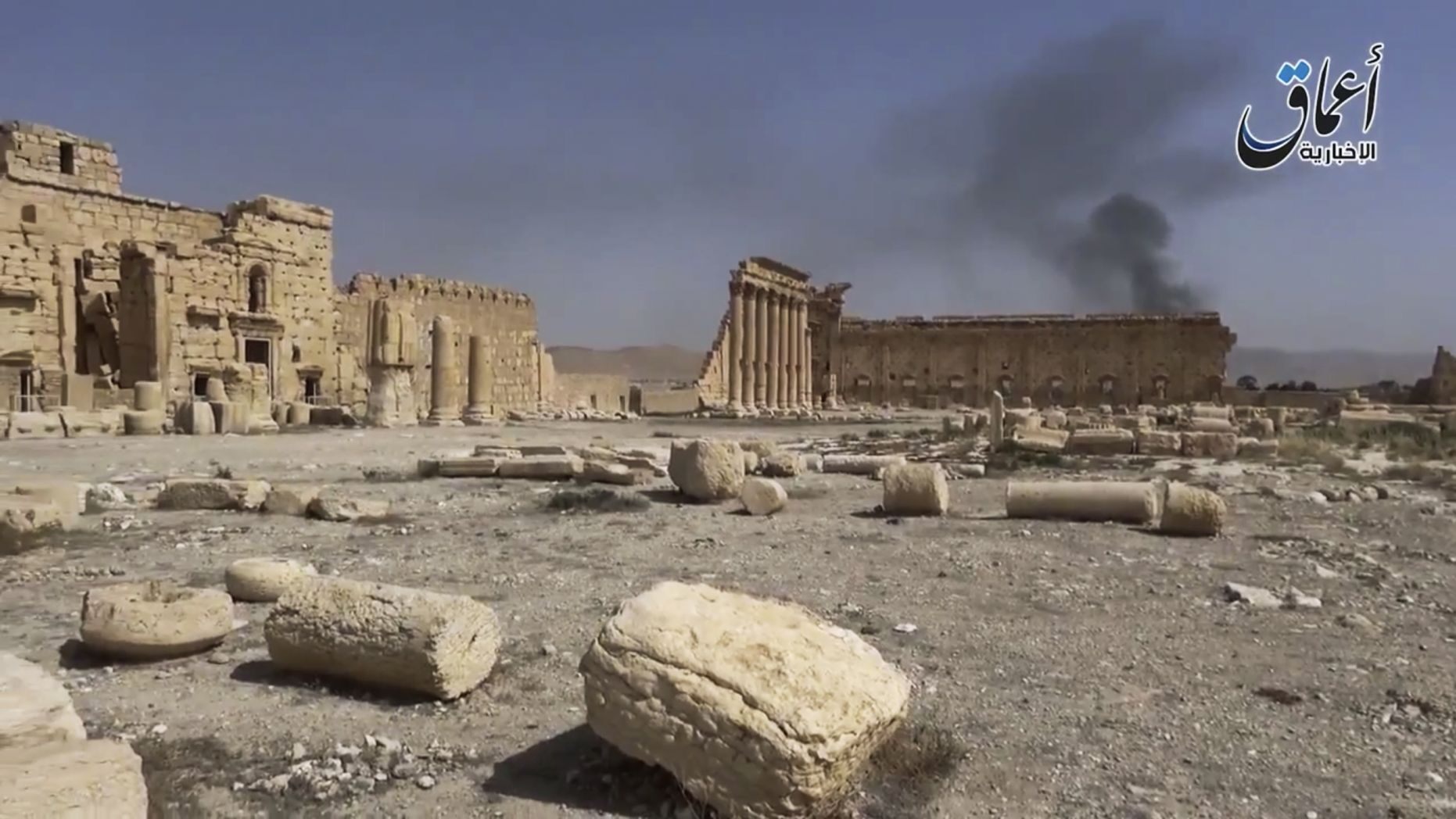Archaeology’s victims of war

The Middle East is largely considered to be the epicenter of the “cradle of civilization,” and has historic sites that date back thousands of years. This region has seen countless armies march across it, leaving not only blood in the sand but also destruction in their wake.
The area around the Ishtar Gate in the ancient city of Babylon, one of the most famous monuments from antiquity, was damaged by military vehicles, which crushed 2,600-year-old brick pavements. Defensive trenches were also dug into the site, which further added to the damage. However, this wasn’t part of recent efforts by Islamic State to destroy ancient Iraqi ruins – it actually occurred following U.S. efforts to remove Saddam Hussein from power in 2003.
That event was just one of several examples of how military conflict has damaged ancient sites. The most recent concerns are that ISIS could destroy the ancient oasis city of Palmyra in Syria, a UNESCO World Heritage Site that dates back thousands of years. Palmyra suffered damage in 2012 during clashes between combatants engaged in the Syrian Civil War, but the site could face total destruction if ISIS gains control of the area.
“Unfortunately, there is no shortage of depressing case studies for the destruction of cultural heritage sites during times of war,” Robert E. Murrowchick, director of the International Center for East Asian Archeology and Cultural History at Boston University, told FoxNews.com. “What better way to display the destruction of your enemy than by looting their art and sacking their historical buildings to whatever extent your military technology allows – from battering rams to siege engines to napalm. It’s a human character flaw and the United States is as guilty as most other countries in playing its part over the past couple hundred years.”
It is said that the winners may write the history but sadly combatants on both sides can do equal amount of damage. Buildings that stood for centuries have been destroyed in the heat of battle. However, some buildings and complexes have fared better than others.
The White House in Washington, D.C. was torched by British soldiers in 1814 but First Lady Dolley Madison had already organized the staff – as well as the first family’s slaves – to gather important artifacts and items including a painting of George Washington. The Kremlin in Moscow, which was burnt with much of the Russian city to keep it from falling into the hands of Napoleon’s La Grande Armée in 1812, was rebuilt and shows few scars today.
1814 print – “The taking of the city of Washington in America.”
1814 print – “The taking of the city of Washington in America.” (Library of Congress)
However, structures such as the Parthenon in Athens, the Porcelain Tower of Nanjing and the Italian monastery of Monte Cassino were severely damaged or outright destroyed. The irony is that these structures had withstood prior sieges and battles but more advanced military technology proved to be too much.
Built circa 438 B.C., the Parthenon actually replaced an older temple dedicated to the goddess Athena that was destroyed during the Persian invasion, and stood for almost 2,000 years largely undamaged. In 1687 it was used as an ammunition dump in the fortified Acropolis, and extensively damaged when a Venetian mortar round set off an explosion. Since 1975 the Greek government has attempted to preserve and restore the ancient temple – and while it will not be restored to its pre-1867 state this ongoing restoration has helped stabilize the building and even correct some prior restoration attempts.
Monte Cassino had been destroyed and rebuilt many times. The Italian monastery, which is located south of Rome, was first constructed on a pagan site devoted to the Roman god Apollo. Saracens sacked and burned the monastery in 884, and it was sacked by the French Army under Napoleon Bonaparte in 1799. It suffered its greatest damage during the Battle of Monte Cassino from January to May 1944.
At the time it was believed the Germans were using it as part of their defensive positions on the Gustav Line, meant to block the Allied advance to Rome. On February 15, 1944 the abbey was destroyed during American-led air raids – and only afterward did the German troops actually utilize Monte Cassino for defensive purposes.
“Monte Cassino was destroyed by Allied artillery and airpower for strategic military reasons, because it was thought to contain a German garrison and because it offered a good position for artillery-spotters,” military historian Nigel Thomas told FoxNews.com. “I don’t believe it was destroyed for the wrong reasons. I believe it had to be destroyed because it was holding up the Allied advance. This is a purely military reason, which is quite different from wanton destruction by ISIS, Taliban or Ustashas.”
Destruction for Religious and Cultural Reasons
As Thomas noted, many buildings were destroyed for military reasons – but many structures and sites have also been completely erased from the Earth during wartime for religious or cultural reasons. Often times these reasons blur, but the result is the same.
“The destruction of cultural and religious sites by the enemy is nothing new, but it is often difficult to disentangle the motives,” Thomas told FoxNews.com. “If Palmyra is destroyed it will be because ISIS is trying to destroy cultural memory, there does not seem to be a religious motive here. However, the Taliban dynamited the Buddhas of Bamiyan in March 2001 because it regarded them as idols.”
An Afghan man rides his motorcycle past the remains of the Giant Buddha destroyed by the Taliban in March 2001 in central Bamiyan province 162 miles northwest of Kabul March 30, 2005.
An Afghan man rides his motorcycle past the remains of the Giant Buddha destroyed by the Taliban in March 2001 in central Bamiyan province 162 miles northwest of Kabul March 30, 2005. (REUTERS/Ahmad Masood)
However, cultural destruction has not been limited to followers of Islamic extremism. Throughout history advancing armies – often with the belief that right was on their side – have laid ruins to important cultural and religious sites.
“In 1941-2 the extreme Catholic Ustasha regime in Croatia destroyed Serbian Orthodox churches, such as Banja Luka Cathedral, and cemeteries, and killed Serbian Orthodox priests and believers,” said Thomas.
“We could also add Nazi destruction of synagogues, in Germany and abroad, whilst respecting Christian and Muslim sites, although the Nazis were technically atheists,” Thomas added.
Total Destruction
Many sites that did stand for centuries are completely gone today. One of the most infamous is the Yuanmingyuan (Summer Palace) outside of Beijing, which was built in the 18th century as the official residence of the emperors of the Qing dynasty. It was sacked and burned during the Second Opium War following the capture and torture of two British envoys.
“This was the less destructive option decided upon by the English and French in retaliation for the killing of some European diplomats in 1860,” said Murrowchick. “Other discussions considered the much more widespread destruction of the city of Beijing itself; these were abandoned as unhelpful in that they would likely incite more of the population to rise up to resist the British and French.”
Instead of condemning the destruction of the Chinese palace, reports suggest that Britain’s Queen Victoria seemed delighted.
“She was even presented with a captured Pekingese dog named ‘Looty’ to celebrate the sacking of the imperial palace complex at Yuanmingyuan,” added Murrowchick.
However, the cultural impact of this site’s destruction carries on to this day.
“The site today is still more or less untouched — the ruins have intentionally been left in ruins as a striking visual reminder of China’s humiliation in the face of more powerful Western armies, a situation that will not be allowed to repeat itself,” Murrowchick told FoxNews.com. “The ruins of the Summer Palace also were used as the primary decorative motif for the nearest subway station built for the Summer 2008 Olympic Games.”
Saving History and its Sites
While many historic sites and artifacts have been lost, much has been saved. As the movie “Monuments Men” chronicled there have even been efforts by some military leaders and planners to save – not loot – historic sites. The George Clooney movie focused on artwork, but during World War II there were other efforts to preserve important cultural sites.
Rome was famously declared an open city during World War, as was Paris. There were even attempts to spare other cities, but these efforts failed.
“Budapest in March 1944 and Belgrade in April 1941 were declared open cities, but the Germans ignored this and both cities suffered serious damage,” added Thomas, who noted that some cities fared better. “General Winkelman, commander of Dutch Armed Forces, surrendered the Netherlands to the Germans on 14th May 1940 following a Luftwaffe bombing raid on Rotterdam which killed 900 civilians. His motive was to avoid further loss of life and destruction of buildings, ancient and modern.”
Perhaps the most famous city to be spared total destruction was Japan’s former capital of Kyoto. The city had been at the top of the atomic bomb sites short list, but Henry Stimson, who served as secretary of war, reportedly opted to spare the city he had visited as a young man and returned to for his honeymoon.



 Creators of mankind
Creators of mankind Description of “Tall white aliens”
Description of “Tall white aliens” Where they came from?
Where they came from? About hostile civilizations
About hostile civilizations The war for the Earth
The war for the Earth “Tall white aliens” about eternal life
“Tall white aliens” about eternal life Video: “Nordic aliens”
Video: “Nordic aliens” Aliens
Aliens Alien encounters
Alien encounters The aliens base
The aliens base UFO
UFO Technology UFO
Technology UFO Underground civilization
Underground civilization Ancient alien artifacts
Ancient alien artifacts Military and UFO
Military and UFO Mysteries and hypotheses
Mysteries and hypotheses Scientific facts
Scientific facts


















